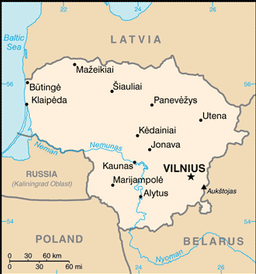Lithuania
 Lithuania is country of Europe located in east Europe.
Lithuania is country of Europe located in east Europe.
Details
| Official Name: | Republic of Lithuania |
| Capital: | Vilnius |
| Total area: | 65 300 km2 |
| GDP per capita: | $21,615 |
| Native Language: | Lithuanian |
| Government: | Parliamentary republic |
| Population: | 2,955,986 |
| Major Religion: | Roman Catholicism |
| Monetary Unit: | Euro (EUR) |
Lithuania is the southernmost of the three Baltic states – and the largest and most populous of them. Lithuania was the first occupied Soviet republic to break free from the Soviet Union and restore its sovereignty via the declaration of independence on 11 March 1990.
The Lithuanian landscape is predominantly flat, with a few low hills in the western uplands and eastern highlands. The highest point is Aukštasis at 294 metres. Lithuania has 758 rivers, more than 2 800 lakes and 99 km of the Baltic Sea coastline, which are mostly devoted to recreation and nature preservation. Forests cover just over 30% of the country.
Some 84% of the population are ethnic Lithuanians. The two largest minorities are Poles, who account for just over 6% of the population, and Russians, who make up just over 5%. The Lithuanian language belongs to the family of Indo-European languages.
The capital, Vilnius, is a picturesque city on the banks of the rivers Neris and Vilnia, and the architecture within the old part of the city is some of Eastern Europe’s finest. Vilnius university, founded in 1579, is a renaissance style complex with countless inner courtyards, forming a city within the city.
The Lithuanian president is elected directly for a five-year term and is active principally in foreign and security policy. The unicameralLithuanian Parliament, the Seimas , has 141 members.
Lithuania’s most famous culinary export is perhaps cold beet soup. Potatoes also make a regular appearance on menus, popular dishes being potato pancakes and Cepelinai – potato dumplings stuffed with meat, curd cheese or mushrooms.
Health & Welfare
The Lithuanian constitution of 1992 provides guarantees of social rights including paid leave for working mothers before and after child birth, old-age and disability pensions, unemployment and sick leave compensation, and free medical care.
Economy & Jobs
Oil production and refining, banking, railroad equipment, electric machinery, appliances, mining, iron, steel, chemical manufacturing, natural-gas, and electric power production.
Main Attractions
Vilnus, Curonian Spit, Druskininkai resort, Hill of Crosses, and Palanga city.
Economy
In 2003, before joining the European Union, Lithuania had the highest economic growth rate amongst all candidate and member countries, reaching 8.8% in the third quarter. In 2004 – 7.4%; 2005 – 7.8%; 2006 – 7.8%; 2007 – 8.9%, 2008 Q1 – 7.0% growth in GDP reflects the impressive economic development and as a result is often termed as a Baltic Tiger. However, 2009 marked a dramatic decline in GDP at −14.74% attributed to overheating of the economy. In 2010, the rate was 1.33%. As of June 2013, the unemployment rate is 10.4%.
Lithuania has a flat tax rate rather than a progressive scheme. In 2007, personal income tax was reduced to 24% and a reduction to 21% was made in January 2009. Lithuanian income levels are lower than in the older EU Member States. According to Eurostat data, Lithuanian PPS GDP per capita stood at 61 per cent of the EU average in 2008.
Immigration and residency
If you are interested in moving to the countries, either with a residence permit or by acquiring a citizenship, please contact us, and also get acquainted with the relevant migration documents.